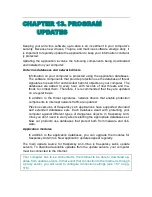
134
Kaspersky Anti-Virus 7.0
the application databases, the date the object was last scanned, and modifi-
cations to scan settings.
Figure 47. Advanced scan settings
For example, you have an archived file that the program scanned and as-
signed the status of not infected. The next time, the program will skip this
archive, unless it has been modified or the scan settings have been
changed. If the structure of the archive has changed because a new object
has been added to it, if the scan settings have changed, or if the application
databases have been updated, the program will scan the archive again.
There are limitations to iChecker™: it does not work with large files and only
applies to objects with a structure that Kaspersky Anti-Virus recognizes (for
example,
.exe, .dll, .lnk, .ttf, .inf, .sys, .com, .chm, .zip, .rar
).
Use iSwift technology
– This technology is a development of iChecker tech-
nology for computers using an NTFS file system. There are limitations to iS-
wift: it is bound to a specific location for the file in the file system and can on-
ly be applied to objects in an NTFS file system.
Register information about dangerous objects in application statistics
–
save information on dangerous objects detected in the application‟s overall
statistics and display a list of threats on the Detected tab of the report win-
















































